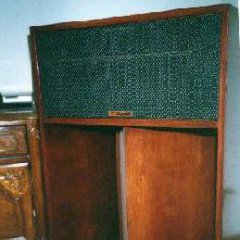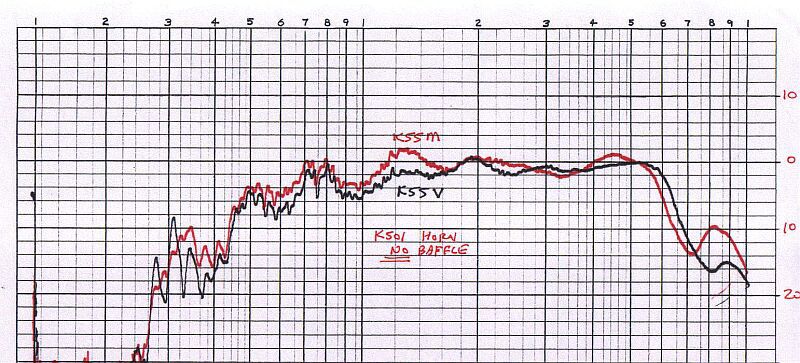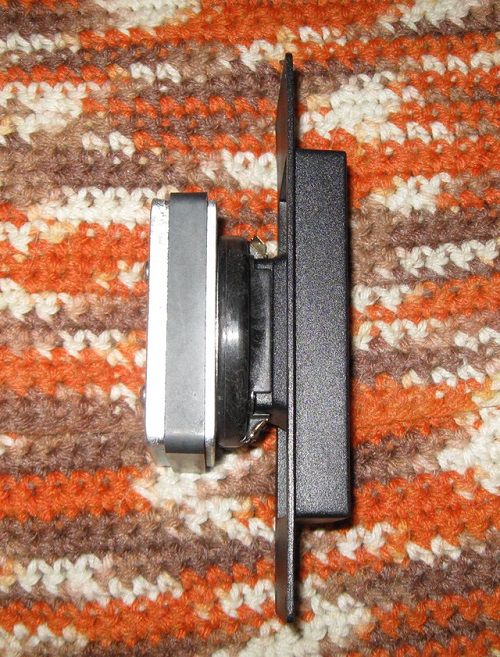-
Posts
5906 -
Joined
-
Last visited
-
Days Won
1
Content Type
Forums
Events
Gallery
Everything posted by JohnA
-

Struggling to understand the power needs of 1983 Cornwall 1.5s
JohnA replied to jason.justice's topic in 2-Channel Home Audio
The rotation angle of your preamp's volume control has little bearing on actual power output, though that is unusually high. To figure the sound level in your room, 1 watt is 98 dB at 1 meter Add an amp and another speaker +6 dB, 104 @ 1m Double the distance to 2m (6.5 feet) is -6 dB, 98 dB Double again to 13 feet, -6 dB, or 92 dB, @ 1 watt, plenty loud for peaks and a 20 watt amp still has 13 dB of headroom for Flim and The BBs. I sit almost 13 feet from my La Scalas. You won't lose quite 6 dB/doubling of distance in a reverberant field (room) so this exercise is conservative. -
Very cool MicroMara, Where might I find such smart phone speakers?
-
-
I added 4 killer subs. La Scalas need low distortion bass below 60-ish Hz. The DJK mod needs a sharp LF filter and some EQ to stand out. Adding 1 to 3 dB (without the filter and EQ) below about 70 Hz helps, but is is not significant.
-
That is a question best asked of Al. Will he respond?
-
Keep pumping the dub step! My new H4 woofers took at *least* 72 hours at tolerable volumes to loosen up so they sounded like the ones I heard in Hope. Have you considered that the old cones were too loose?
- 1 reply
-
- 1
-

-
I have never heard H2s or H3s, but everyone I know at Klipsch says the H3 woofer is a nice upgrade to the 2s. Supposedly the H4 woofer is the same. Were I serious about upgrading now that I've had H4s for a year+, I'd go with the H3 kit (new caps/inductors) and look about adding volume and a port to make my own H4. A small box added to the rear with a port into the original cabinet ought to do it. Perhaps ClaudeJ1 will help you with the calculations.
-
I made my own speaker cables from braided CAT 5E plenum rated (teflon insulation) cable. I twisted 3 pair and braided those 3. Finished with sore fingers. They are about equal to 11 gauge wire. And they do look cool! I'm sure they measure impeccably. I could hear a difference in my KLF-C7, probably because of the lower midrange impedance.
-
The black plastic cased capacitors were OEM Klipsch for a while in the 990s maybe before. Your K-42-E looks to be an Eminence (speaker company) made copy of the EV EVM-12L, the woofer I had in my early '80s HIPs. Your English is excellent.
-
Use a concrete anchor. Drill matching hole in ball and tighten. Use coupler to attach a threaded rod. Lube barrel and ball with motor oil. Drill hole for threaded rod in steel plate, 3/8" or so. Place plate over rod and against muzzle while attached to ball. Add nut and slowly draw threaded rod and ball to muzzle. You can use wooden blocks under the steel plate to help pull the ball the last few inches.
-
TL;DR So many comments, I'm not sure I will offer much more. Here's what I do/did. And I'd recommend in this order. Place them 2 to 3 feet out of the corner or about 2 feet off the wall. Add several uber-performance subwoofers, not only for output, but to try to match the La Scala's very low distortion. Replace the caps with high quality film and foil caps. They don't need to be $300 each, but it will be expensive. Delete the diodes. Front/flush mount the tweeters to reduce diffraction by the motorboat. Klipsch made Z brackets and a flanged K-77 to do it. You can also buy horns that use the excellent B&C DE120 tweeter. A tractrix tweeter horn will sound better. Alternately, you can place the tweeters on top of the cabinet, vertically aligned with the squawker parting line; that will approximately time align the squawker and tweeter, the worst time misalignment in the system. Wrap the squawker horn in Dynamat of equal to damp small vibrations. Then, line the motorboard opening with thick felt or front mount the squawker to reduce diffraction at the mouth. Felt is cheap and easy. Stuff the upper cabinet with pillow stuffing knock on the top with your knuckles to see why. Buy DVD-Audio discs.
-

CF-4 Owner Looking to Upgrade from Rotel RX-1052
JohnA replied to bpplaysguitar's topic in 2-Channel Home Audio
You already have 2 to 4 times as much power as you need and a good amp. Be happy. Spend that money on DVD-Audio discs or quality vinyl. -
I power my H4s with a refurbished late seventies Technics 35 watt receiver. I like the results. Maybe focus more on room and placement than power amp.
-
I talked to Gil a few minutes ago. His wit is as sharp as ever, but he is bored and requested calls. PM me and I'll give you his new number.
-

la scala's...where is that 15" woofer anyway...
JohnA replied to steck's topic in Technical/Restorations
K-33s are 4 ohms. 2226s are 8 ohms. You will not damage anything trying it, but the woofer low pass point will be off 1 octave and its output may be less, by 3 dB. -
I did something like babadono did for my work bench. If you use plastic boxes, it will look less industrial. I would use 12 gauge wire, minimum. Stranded wire will be more flexible.
-
Is there only one? SN 193 is so old, I'm unsure of the correct drivers. The EV EVM-15L woofer, is a good woofer, but may not be the best choice for the bass horn. It was still in production a few years ago and can be readily reconed, if needed. The University ID-40 is the midrange, aka Squawker. I would have thought a University SA-HF would have been original. I have one I am not going to use; you can have for a nominal sum, if it is the original driver. Few (none?) of that age had tweeters. Mr. JRH will clear up the fog, in a bit. Klipsch often sold upgrade kits for older K-horns that added a tweeter, a newer squawker and revised crossover. An upgrade to 3-way would be the best for sound, but, #193 has some value of it's own due to its age.
-
Crites Speakers usually stocks replacement diaphragms, some pre-mounted so the replacement is an easy DIY job. You DO want the later T-350/T-35 diaphragm with ribbon leads for it higher power handling capacity (5 cont/50/100 peak?). I find the DE120 driver on a true tractrix horn to be silky smooth and natural sounding. I like it better than my original K-77-Ms. You should at least try to front mount your K-77s to get them out of the tunnel they fire through.
-

Picking up my LaScala's next week, what next?!
JohnA replied to JAGX's topic in General Klipsch Info
Good. -

Picking up my LaScala's next week, what next?!
JohnA replied to JAGX's topic in General Klipsch Info
If you are going with a separate power amp, buy a pre/pro and do it all the way. I'll recommend a high quality AVR. Running Klipsch speakers, you will not push it hard enough to need or justify an outboard power amp. Quality is important and won't be cheap, but just because it is an AVR doesn't make it inferior or unworthy. https://www.audioadvice.com/home-theater/home-theater-components/home-theater-receivers I use my system for 2 channel and HT, with all separates. I use my pre/pro to switch video, too. That is convenient and doesn't degrade the picture. It will make integrating all your inputs into a system that is easy enough others can use it. My lady friend can watch TV when I'm away from home without call me for help. I use a modified Heresy (xover very similar to my La Scalas) as a center. A Heresy IV may be the best center for you. You should look at 2 or more subs. Having gone from 1 to 2 to 4, I'll keep 4 if at all possible. Four (many), reduces cone excursions making the distortion similar to my La Scalas. Spreading them around the room fills in nulls a single sub will suffer. -
VDS, I *might* be able to talk my GF into selling her 604-8Gs, rebuilt to new with GPA parts. They will be >$1400 for the pair and there is always a new excuse not to sell, but maybe.
-
-
They are kg2s. I have a pair in similar condition I paid $100 for a few years ago.
-
I had one pair with Type AL xovers. The eq built in them caused a howling resonance in the range of a French horn. My solution was a set of Al Klappenberger crossovers. Type AL-3s will be your best bet. You can convert your Type ALs. There is enough difference in output between a K-55-M and -V that the vaunted Type AA is not a good match. The K-77-M is a good tweeter. As always, there is something better at higher cost. If you want to replace them, try to get a later K-77-F that flush mounts the tweeter mouth, or Z brackets that do the same with your tweeters. Should you decide to go with bespoke tweeters, be sure the horns have properly made exponential or tractrix horns. The tractrix horn curve is a little better. A K-77-? uses an exponential curve. Flush mounting the tweeter eliminates some audible harshness from reflections. Don't do what I did and disassemble the tweeters and reassemble them through the cabinet holes. They might just fall to pieces in your hands! It IS a way to improve the sound.






